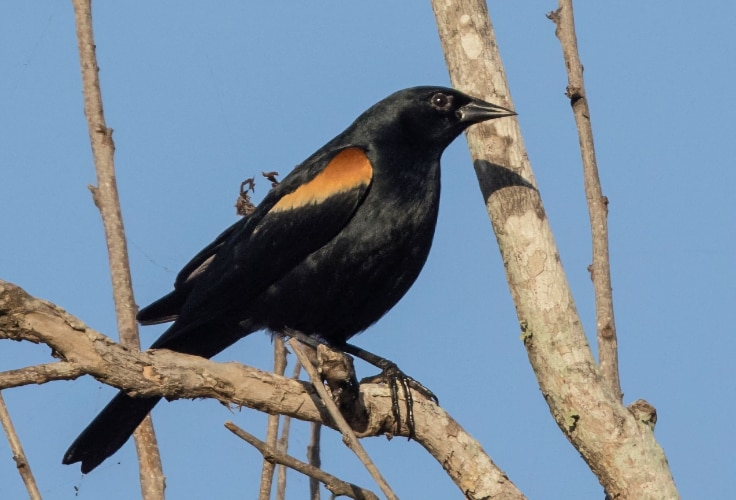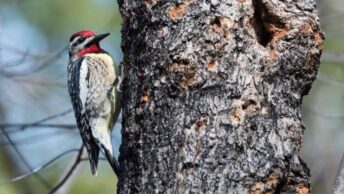The most distinctive black birds with red or orange wings are the red-winged blackbird, common and widespread across North America, and the tricolored blackbird, a similar but more localized species of the West. A few other blackbirds occur farther south, displaying the same vivid shoulder markings in the wetlands and open landscapes of the Caribbean.
This guide highlights these striking species and their regional counterparts, outlining how to recognize them in the field by plumage, behavior, and habitat. Each entry includes identification notes, typical environments, and field cues to help distinguish males, females, and similar-looking species.
Red-Winged Blackbird
Agelaius phoeniceus
- Identification: Medium-sized blackbird; males glossy black with vivid red shoulder patches bordered in yellow, females heavily streaked brown with a pale eyebrow.
- Where found: Across North America in wetlands, pastures, and roadside marshes.
- How to spot: Look for males singing from cattails or wires, flashing their red epaulets during display; listen for the distinctive “conk-la-lee” song. Often in large flocks outside breeding season.
- Conservation status: Least Concern (IUCN); still abundant but showing gradual population declines across much of its range.

The red-winged blackbird is the most widespread example of a black bird with red wing markings, a flash of color that makes it stand out in wetlands and meadows across North America. It measures 15-25 centimeters (5.9-9.8 inches) in length, with males in some populations noticeably larger than females. Males are glossy black with bold scarlet-and-yellow shoulder patches, while females are brown and heavily streaked, with a pale eyebrow and buffy throat, sometimes showing faint orange on the shoulder.

In the field, the species is conspicuous and vocal. Males perch on cattails, fence posts, or wires, singing the tumbling “conk-la-lee” song and flashing their epaulets to advertise territories. Their flight is strong and slightly undulating, often with the red shoulders visible in motion. They forage both on the ground and on vegetation, using a characteristic “gaping” technique to pry open plant bases and uncover insects. Outside the breeding season, they form massive flocks (sometimes numbering in the millions) together with other blackbirds and starlings. Males are highly territorial and may aggressively chase intruders or predators, even large mammals or humans, during the nesting period.
Red-winged blackbirds breed in a broad range of habitats, from freshwater and saltwater marshes to meadows, pastures, and croplands. They occur across most of North America, from Alaska and Canada south through the United States, Mexico, and into Central America and the northern Caribbean. Northern populations migrate southward in autumn, while southern birds remain resident year-round. Despite being one of the continent’s most abundant native species, long-term monitoring shows gradual declines, particularly in agricultural regions, linked to habitat changes and pesticide use.
Tricolored Blackbird
Agelaius tricolor
- Identification: Medium-sized blackbird; males glossy black with red shoulder patch bordered by a white bar; females dark brown and streaked, larger and darker than sparrows, sometimes showing faint orange on the shoulder.
- Where found: Restricted to California and nearby regions of Oregon, Washington, Nevada, and northwestern Baja California; favors wetlands, rice fields, and irrigated farmlands.
- How to spot: Look for dense, noisy colonies in marshes and croplands; males sing harsh, catlike “ker-aaah” notes and display red-and-white shoulders during territorial or courtship displays.
- Conservation status: Endangered (IUCN); populations have fallen by more than 80% in recent decades due to habitat loss and agricultural practices.

The tricolored blackbird is a close relative of the red-winged blackbird but far more restricted in range, occurring mainly in California and distinguished by its red-and-white wing patch. It measures 18-24 centimeters (7.1-9.4 inches) in length, with males glossy black and marked by vivid red shoulder patches bordered sharply in white instead of yellow. Females are dark brown and heavily streaked with a whitish throat and pale eyebrow. Both sexes have a slender, pointed bill, longer and narrower than that of their widespread cousin.

Highly social in every season, this species forms dense colonies that can contain thousands of pairs, all nesting within a confined patch of cattails or agricultural vegetation. Males perch atop reeds or shrubs, giving their harsh, mewing “ker-aaah” song while spreading wings and tail in display. Flocks move together in tight, direct flight lines between foraging sites and colonies, often flying low over fields. Their calls create a continuous chorus that can carry for over a kilometer – a sound unique among North American songbirds. Outside the breeding season, they remain gregarious, roosting and feeding in large mixed flocks with other blackbirds and starlings.
The species’ range is centered on California’s Central Valley, with smaller breeding populations in Oregon, Washington, Nevada, and formerly northwestern Baja California. It favors wetlands, flooded pastures, rice paddies, and grain fields where insects and seeds are abundant. Habitat loss from urban development, drainage, and agricultural conversion has caused dramatic declines. Many colonies now nest in triticale and alfalfa fields, where mowing before young have fledged leads to high mortality. Conservation programs are working with farmers to delay harvests, protect colonies, and restore wetland habitats essential to the species’ survival.
Red-Shouldered Blackbird
Agelaius assimilis
- Identification: Medium-sized blackbird; males glossy black with a red shoulder patch bordered by yellow-buff; females entirely black but duller and lacking colored epaulets.
- Where found: Endemic to Cuba, including Isla de la Juventud; occurs mainly in freshwater marshes with cattails and bulrushes.
- How to spot: Look for small groups in reedy wetlands; both sexes sing similar shrill “o-wi-hiii” notes, often in duets; rarely leaves marsh habitat.
- Conservation status: Least Concern (IUCN); locally common but confined to patchy wetland areas, making it vulnerable to habitat loss.

The red-shouldered blackbird is Cuba’s own representative of the red-winged group – a striking blackbird whose males bear vivid orange-red wing markings with a pale yellow-buff edge. Measuring 20-22 centimeters (7.9-8.7 inches) in length, it closely resembles the red-winged blackbird but is smaller and longer-legged. Unlike its North American relatives, both sexes are similar in size and shape, and females are entirely black without streaks. Juveniles are also dark and nearly adult-like from fledging, a rare trait among blackbirds.
This species is largely confined to reedy marshes, where pairs remain year-round within their territories. Both sexes sing – a sharp, creaking “o-wi-hiii” given singly or in duet, and share nest defense and feeding duties. The male’s bright shoulder patch is displayed during song, but its breeding system is monogamous, unlike the polygynous red-winged blackbird. Birds forage mostly on the ground for insects, small vertebrates, fruits, and seeds, often joining mixed flocks with tawny-shouldered and Cuban blackbirds outside the breeding season.
Endemic to western and central Cuba, including Isla de la Juventud, the red-shouldered blackbird inhabits freshwater marshes dominated by cattails, bulrushes, and sedges. It nests low among emergent vegetation and occasionally forages in nearby fields and pastures. Though locally common, its range is fragmented and closely tied to suitable wetland habitat. Populations remain strong in large marshes such as the Cienaga de Zapata but are sparse elsewhere, making continued habitat monitoring important for this island endemic.
Tawny-Shouldered Blackbird
Agelaius humeralis
- Identification: Medium-sized blackbird; males and females black overall with a warm tawny-orange shoulder patch edged pale; sexes similar, females slightly duller and less glossy.
- Where found: Native to Cuba and western Hispaniola; common in open woodlands, farmland, and at the edges of wetlands and rice fields.
- How to spot: Look for small, sociable groups foraging in trees or on the ground; the orange shoulder patch is most visible in flight; listen for rough “chet” and metallic “willeee” calls.
- Conservation status: Least Concern (IUCN); widespread and adaptable, thriving even in human-altered landscapes.

The tawny-shouldered blackbird is a close Caribbean relative of the red-winged group, recognized by its warm orange shoulder patch set against a glossy black body. Measuring 19-22 centimeters (7.5-8.7 inches) in length, it shows little sexual dimorphism – males and females look much alike, though females are slightly duller and lack the male’s bluish gloss. This species differs from the red-shouldered blackbird by its paler, more orange-toned epaulet and broader distribution, extending beyond Cuba into western Hispaniola.
Highly social and tolerant of varied habitats, it frequents open woodlands, edges of marshes, and cultivated areas. The species forages both on the ground and among shrubs and trees, feeding on insects, seeds, small lizards, fruit, and nectar. During the non-breeding season, it often joins large mixed flocks with other blackbirds. Both sexes sing – a low, buzzing call or a short duet, and exchange nasal “chet” and metallic “willeee” notes. Pairs typically nest semi-colonially, building cup-shaped nests in trees or palms, often near water.
Unlike its marsh-bound relatives, the tawny-shouldered blackbird adapts readily to human-altered environments and remains common across Cuba. It is more localized in western Haiti, especially around the Artibonite River and Port-de-Paix, where suitable woodland persists. Its flexibility in feeding and nesting habits has allowed it to remain stable even as wetlands shrink, making it the most widespread and adaptable member of the Caribbean orange-shouldered blackbirds.
Other Black Birds with a Flash of Red
From temperate marshes to Caribbean wetlands, these blackbirds show how a flash of red or orange transforms even the darkest plumage into something instantly recognizable. If you travel farther south into Central and South America, we encourage you to explore other blackbirds with red markings – the scarlet-rumped and red-rumped caciques, whose glossy black plumage and vivid red lower back can, from certain angles, look like a continuation of the wings.



